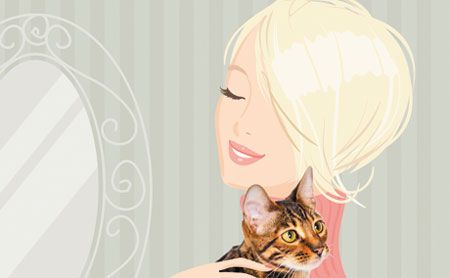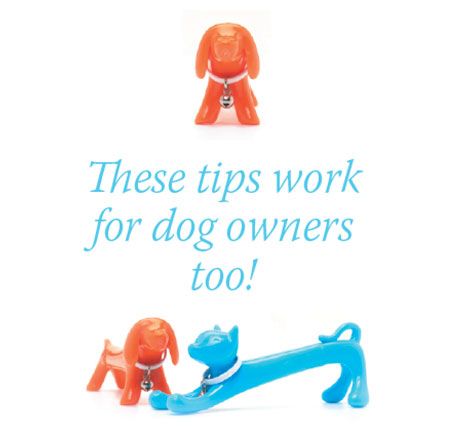Help clients chillax so their pets can, too!
She flies into your veterinary exam room, a whirling fury of claws and teeth. And if you can just get her to chill out, you might get her cat to relax too.

Getty imagesIt's no coincidence that your kitty always curls up on your lap when you're feeling blue. Just as we try to read our pets' moods, they're trying to read us too-and this is an area where pet owners play a crucial role in the success of their pet's veterinary visit. Now it's completely true that some pets will be anxious regardless of how the pet owner acts. But many times pet owners can influence their pets' moods, for better or for worse. Use these eight tips to calm freaked out pet owners.

Mine for conversation game-changers
If you're with stressed clients, ask them about something you know strikes their passion-for example their latest big catch or their daughter's ballet recital. When you strike the right topic, their entire body and facial expression lighten up as they move from worry into pleasure.
Photos by Greg Kindred

Change the environment
It's not only dogs and cats who have associations with different environments-people do too! If a person seems tense with an aspect of the veterinary visit, try another approach. Some examples: examining the dog while on bedding material on the floor or examining the cat in the comfort of a top removal crate rather than the exam table. This takes away some tension from previous experience. Make the visit individual and personal for the pet and client. For instance, one woman and her dog were most comfortable in the waiting area, so the veterinary team performed her basic exam in this area rather than the exam room, where previous panic episodes had occurred.

Focus on the furry friend in the room
Ask about their favorite activity with their cat or dog and what the pet enjoys. You may uncover important information, such as a favorite toy, treat or place to be petted that you can use to keep the animal calm. It also gives pet parents a way to share what's important to their animal and even offer an element of control to keep their pet calm. Ask if their pet has any favorite tricks. If they do, ask and reward the animal for any attempt to do the trick. This personalizes the visit, where you demonstrate the pet is a unique individual-and you lighten the mood. After all, people and their animals enjoy tricks that offer fun and rewards.

Give the why
Tell clients it's important for everyone to stay relaxed to help the pet. If this feels too forward, I've found when I describe my own way of using my body language to keep the animal calm, people will often mimic it in response. And just as positive reinforcement works with cats and dogs, it helps with people too. For instance, when clients hold a leash too tight, restricting the pet, if they loosen the leash, commend them immediately for their loose leash. Many people will loosen the leash further and consciously make an effort to avoid holding the leash so tight.

Put pet owners to work
Sometimes people do better if you offer them something to focus on or a task to perform. Directing clients' energy to help their pet may lessen their nervous energy. These tasks could include holding a stuffed food puzzle while the animal eats out of it and your doctor performs the examination. Or it may be doling out treats by hand or petting and talking to their cat.

Create a soothing environment
Dentist offices often use fish tanks because of their tranquil effect, lowering the stress and anxiety levels of people. The effect may be similar to that of hypnosis. Fountains may also promote a relaxing backdrop. Additionally, lighting and color of rooms may reduce pet owners' stress. Shades of blue are reported to be the most calming for people. A Minnesota State University study found stress was increased the most in red environments, but not in white or green environments. Dusty and muted shades of colors are potentially better than bold colors. Passive pink, or bubble gum pink, is believed to be such a calming color it's used to soothe patients in hospitals and calm those in correctional facilities. Also check out the color palette for calming pets. Classical music is known to calm people and pets, and may be a great acoustical backdrop for the hospital. Finally, think about lighting. Florescent lighting has been found in numerous studies to elevate stress response. Sunlight and incandescent lighting are better types of lighting to reduce stress.

Play pet the pussycat (or pooch!)
One of the best ways to calm people may be right in front of them; their own dog or cat. Petting and talking to their pet may be soothing for the person and their animal. Sometimes people may agitate or upset their animal, but if the animal seems calmed by touch, it's a great way to keep both pet and person calm. Such petting has been shown to lower blood pressure and elevate levels of feel-good hormones, like oxytocin.

Practice the visit before the real thing
Encourage owners to come in for fun, frequent visits between their veterinary appointments. The fun visits help both pets and people feel more comfortable and to gain confidence. If clients need extra help, it's important to provide resources, such as training or behavior help though referral or classes to help prepare for more relaxed visits in the future. Use this free handout to teach pet owners how to use practice visits to prepare for a better experience at the veterinarian.

It's important to address the wellbeing of everyone at the hospital, including members of your veterinary team. We can't overlook the emotional link between people and pets. In the process of creating Fear Free visits, we need to improve the emotional state of pets-and their people!
Mikkel Becker, CPDT, works with veterinarians and veterinary behaviorists to address behavior issues in dogs and cats.